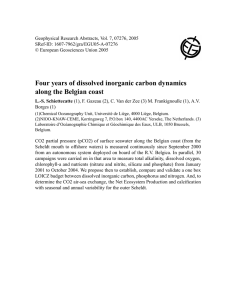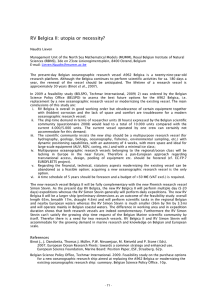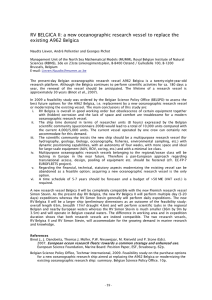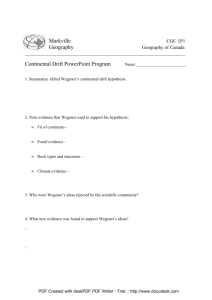Moving plates and melting icecaps – Processes and forcing factors... international Geologica Belgica meeting, September 11-14, 2012
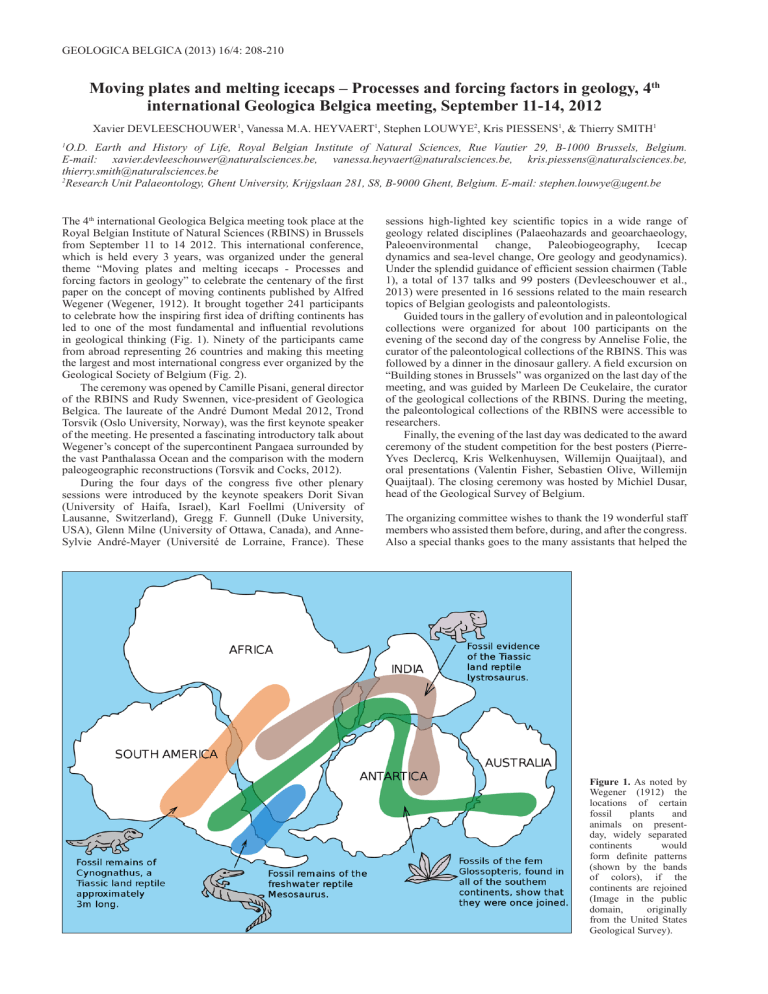
GEOLOGICA BELGICA (2013) 16/4: 208-210
Moving plates and melting icecaps – Processes and forcing factors in geology, 4
th
international Geologica Belgica meeting, September 11-14, 2012
Xavier DEVLEESCHOUWER 1 , Vanessa M.A. HEYVAERT 1 , Stephen LOUWYE 2 , Kris PIESSENS 1 , & Thierry SMITH 1
1 O.D. Earth and History of Life, Royal Belgian Institute of Natural Sciences, Rue Vautier 29, B-1000 Brussels, Belgium.
E-mail: xavier.devleeschouwer@naturalsciences.be, vanessa.heyvaert@naturalsciences.be, kris.piessens@naturalsciences.be, thierry.smith@naturalsciences.be
2 Research Unit Palaeontology, Ghent University, Krijgslaan 281, S8, B-9000 Ghent, Belgium. E-mail: stephen.louwye@ugent.be
The 4 th international Geologica Belgica meeting took place at the
Royal Belgian Institute of Natural Sciences (RBINS) in Brussels from September 11 to 14 2012. This international conference, which is held every 3 years, was organized under the general theme “Moving plates and melting icecaps - Processes and forcing factors in geology” to celebrate the centenary of the first paper on the concept of moving continents published by Alfred
Wegener (Wegener, 1912). It brought together 241 participants to celebrate how the inspiring first idea of drifting continents has led to one of the most fundamental and influential revolutions in geological thinking (Fig. 1). Ninety of the participants came from abroad representing 26 countries and making this meeting the largest and most international congress ever organized by the
Geological Society of Belgium (Fig. 2).
The ceremony was opened by Camille Pisani, general director of the RBINS and Rudy Swennen, vice-president of Geologica
Belgica. The laureate of the André Dumont Medal 2012, Trond
Torsvik (Oslo University, Norway), was the first keynote speaker of the meeting. He presented a fascinating introductory talk about
Wegener’s concept of the supercontinent Pangaea surrounded by the vast Panthalassa Ocean and the comparison with the modern paleogeographic reconstructions (Torsvik and Cocks, 2012).
During the four days of the congress five other plenary sessions were introduced by the keynote speakers Dorit Sivan
(University of Haifa, Israel), Karl Foellmi (University of
Lausanne, Switzerland), Gregg F. Gunnell (Duke University,
USA), Glenn Milne (University of Ottawa, Canada), and Anne-
Sylvie André-Mayer (Université de Lorraine, France). These sessions high-lighted key scientific topics in a wide range of geology related disciplines (Palaeohazards and geoarchaeology,
Paleoenvironmental change, Paleobiogeography, Icecap dynamics and sea-level change, Ore geology and geodynamics).
Under the splendid guidance of efficient session chairmen (Table
1), a total of 137 talks and 99 posters (Devleeschouwer et al.,
2013) were presented in 16 sessions related to the main research topics of Belgian geologists and paleontologists.
Guided tours in the gallery of evolution and in paleontological collections were organized for about 100 participants on the evening of the second day of the congress by Annelise Folie, the curator of the paleontological collections of the RBINS. This was followed by a dinner in the dinosaur gallery. A field excursion on
“Building stones in Brussels” was organized on the last day of the meeting, and was guided by Marleen De Ceukelaire, the curator of the geological collections of the RBINS. During the meeting, the paleontological collections of the RBINS were accessible to researchers.
Finally, the evening of the last day was dedicated to the award ceremony of the student competition for the best posters (Pierre-
Yves Declercq, Kris Welkenhuysen, Willemijn Quaijtaal), and oral presentations (Valentin Fisher, Sebastien Olive, Willemijn
Quaijtaal). The closing ceremony was hosted by Michiel Dusar, head of the Geological Survey of Belgium.
The organizing committee wishes to thank the 19 wonderful staff members who assisted them before, during, and after the congress.
Also a special thanks goes to the many assistants that helped the
Figure 1.
As noted by
Wegener (1912) the locations of certain fossil plants and animals on presentday, widely separated continents would form definite patterns
(shown by the bands of colors), if the continents are rejoined
(Image in the public domain, originally from the United States
Geological Survey).
4 TH I nTernaTIonal
G eoloGIca
B elGIca
M eeTInG
Table 1. Distribution of the different scientific sessions and their respective chairmen, and the quantitative corresponding contributions by topics.
S : Session, N : number of contributions.
curators of the RBINS to organize their guided tours and field excursion. The Royal Belgian Institute of Natural Sciences is thanked for giving us the opportunity to organise this conference and supporting the event by offering conference rooms and technical assistance. The Belgian Science Policy Office (Belspo) was especially supportive to this conference through its Event
Support service, which helped with the logistics by installing supplementary audiovisual equipment in the conference rooms.
Seven researchers from six different institutions in India were funded by Belspo project BL/36/fwi05 and two participants were supported by the department paleontology of the
RBINS. Numerous sponsors supported this Geologica Belgica conference including the French and Flemish Research Science
Foundations (FWO/FNRS), the Foreign Affairs, External Trade and Development Cooperation through the GECO project, the communications agency for tourism in the Brussels-Capital
Region (VISITBRUSSELS), the International Association of Sedimentologists (IAS), the Belgian union for Quaternary research (BELQUA), Eijkelkamp Agrisearch Equipment, GF
Consult for the mineral industry, and the Delirium brewery.
References
Devleeschouwer, X., Heyvaert, V.M.A., Louwye, S., Piessens K. & Smith
T., 2013.
Moving plates and melting icecaps. Processes and forcing factors in geology. 4 th International Geologica Belgica Meeting 2012.
Abstract book (ISBN 978-2-9601402-0-0), 1-300.
Torsvik, T. H. & Cocks L. R., 2012. From Wegener until now: the development of our understanding of Earth’s Phanerozoic evolution.
Geologica Belgica, 15(3), 181-192.
Wegener, A., 1912. Die Entstehung der Kontinente. Geologische
Rundschau, 3, 276-292.
Available online 10.10.2013
209
210 X. D evleescHouwer
, v. M.a. H eyvaerT
, s. l ouwye
, K. P
Iessens
& T. s
MITH
Figure 2. Different moments of the 4 th international Geologica Belgica meeting. A. Opening ceremony. B. Awarding of the André Dumont Medal 2012 to
Trond Torsvik from the University of Oslo by Rudy Swennen, vice-president of Geologica Belgica. C. Participants in the main auditorium of the RBINS with an Indian delegation in the foreground. D-E. The poster room. F. Closing ceremony by Michiel Dusar, associate editor of Geologica Belgica. G.
Evening guided tour in the gallery of evolution.
